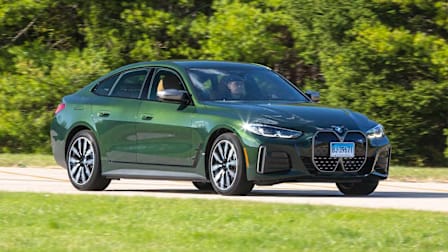Automakers Are Adding Electric Vehicles to Their Lineups. Here's What's Coming.

Many automakers have detailed plans to electrify large portions of their fleets over the next decade, with some announcing goals for fully electrified lineups within five years.
Consumers might not even have to wait that long. Dozens of pure battery electric vehicles (BEVs) are set to debut by the end of 2024 if all goes according to plan.
Going Electric?
American Honda Motor Co.
American Honda—which sells popular Honda- and Acura-branded cars, SUVs, and pickups to American consumers—has long dabbled in electrified cars. It started with the EV Plus hatchback over 20 years ago, followed by the original Insight and Civic hybrid. There is a new Accord and CR-V hybrid that will be followed by a wave of electric models.
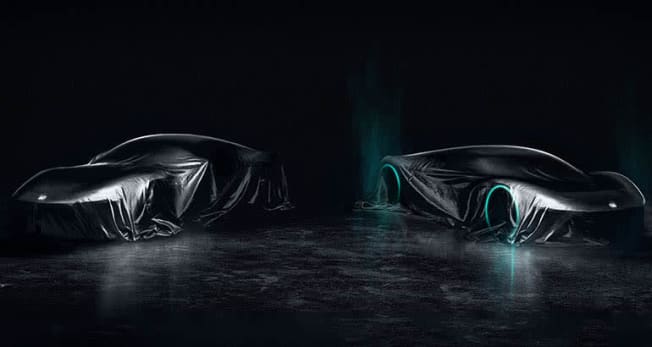
Photo: Honda Photo: Honda
The company aims for all its sales to be zero-emissions electrified vehicles by 2040. The projected ramp-up to this goal is 40 percent of sales by 2030 and 80 percent by 2035. To accomplish this goal, Honda has formed a couple of major partnerships and committed to investing $40 billion in EV research and development, including engineering solid-state batteries.
Looking beyond cars, the automaker said in a statement, “As the world’s largest power unit manufacturer with annual sales of approximately 30 million units of mobility products, including motorcycles, automobiles, power products, outboard motors and aircraft, we aim to realize carbon neutrality for all products and corporate activities Honda is involved in by 2050, striving to eliminate carbon emissions from power sources of a wide variety of products.”
Honda has teamed up with General Motors, an arrangement that allows Honda to make use of GM’s coming Ultium batteries, a proprietary technology that GM says will allow long-range electric travel, among other benefits. The accord also calls for mutual vehicle platform-sharing, which will allow either automaker to use the basic building blocks of GM’s electric vehicle architecture in designing and building its own cars. The first model co-developed with GM is the Prologue SUV, on target for sales in 2024.
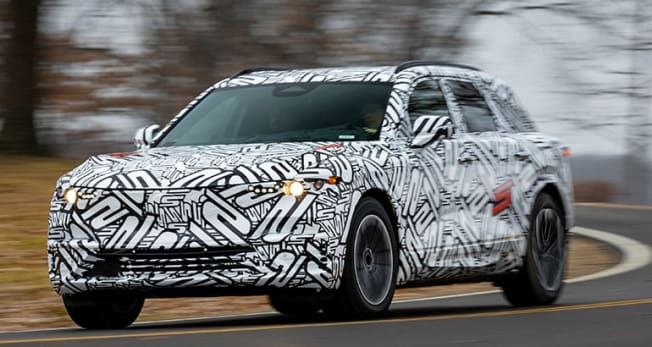
Photo: Acura Photo: Acura
The 2024 Acura ZDX SUV will be produced at the GM plant in Tennessee, where GM plans to build the Cadillac Lyriq EV.
Honda announced that they had formed a joint venture with LG Energy Solution to produce lithium-ion batteries in the U.S. for upcoming Acura and Honda models. It plans to invest $3.5 billion in the new battery plant in Ohio.
For 2026, Honda will begin production of new models based on its e:Architecture platform. The company said, “Through the alliance with GM, Honda is planning to introduce affordable EVs in 2027, with a cost and range that will be as competitive as gasoline-powered vehicles, starting from North America.”
Honda and GM are working together to enable global production of millions of EVs starting in 2027, with a particular focus on small SUVs. To accomplish that, they’re cooperating on standardizing equipment and processes to keep costs down.

Photo: Sony Honda Mobility Photo: Sony Honda Mobility
In addition, Honda formed a joint venture with Sony to produce battery electric vehicles together under the brand Afeela. The first prototype, shown at CES in January 2023, features electronics galore, including 45 cameras and sensors. It previews a production model. Sony Honda Mobility announced that orders would begin in 2025, with deliveries scheduled for 2026.
BMW North America
BMW got into the EV game relatively early with its i3, an electric city car that has had limited success in the U.S. since becoming available at dealerships here for the 2014 model year. It was joined by the rather exotic i8 sports car.
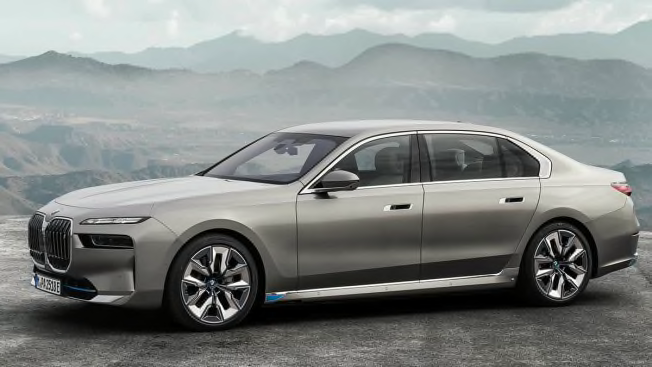
Photo: BMW Photo: BMW
Since that first electric wave, the automaker has steadily introduced new production models, including the i4 and iX SUV. Plus it has announced plans to introduce electric versions of the 5 Series and the X1 SUV. In all, BMW says it will bring roughly a dozen new EVs to market by 2025. Mini and Rolls-Royce also fall under the BMW umbrella; a Mini Cooper electric model is already available, and an electric Rolls-Royce Spectre is coming in 2023.
Read our BMW iX first drive.
Ford Motor Company
Ford offers the Mustang Mach-E, e-Transit van, and F-150 Lightning.
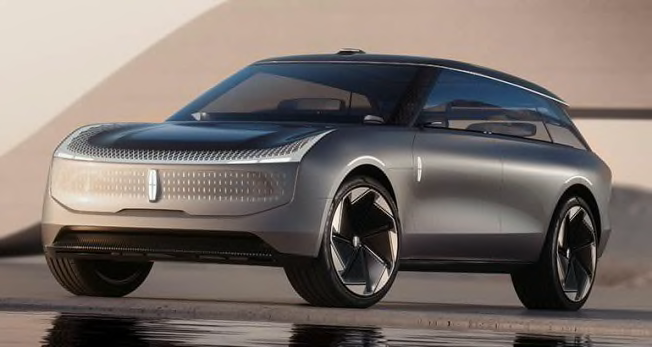
Photo: Lincoln Photo: Lincoln
To further its electric ambitions, the automaker has split operations between electric (Model e division) and internal combustion engine (Blue division). These new organizations will work together but operate as distinct businesses starting in 2023. By being singularly focused, Model e is expected to accelerate electric vehicle development.
Ford says it will produce more than 2 million EVs annually by 2026 and projects that EVs will be half of its global sales volume by 2030. The automaker also says that half the global sales of its Lincoln luxury brand will be zero-emissions models by the middle of this decade and that it will electrify the entire portfolio of vehicles by 2030.
General Motors
GM—which includes the Buick, Cadillac, Chevrolet, and GMC brands—has a long history with EVs that began in the late 1990s with the EV1. Then came the Chevrolet Volt plug-in hybrid and the all-electric Chevrolet Bolt and now the Bolt EUV.

Photo: Chevrolet Photo: Chevrolet
GM aims to have 20 EVs available in the U.S. by 2025 as it moves to an all-electric model lineup by 2035. The GMC Hummer EV will be followed by the Cadillac Lyriq SUV and Celestiq sedan; Chevrolet Blazer EV, Equinox EV, Silverado EV; and GMC Sierra EV. In addition, the Chevrolet Corvette will be offered as a hybrid in 2023, with an all-electric version to follow. Beyond the power boost from electricity, the Corvette will be all-wheel drive for the first time. Buick will launch its first electric vehicle in 2024, as it charges ahead to offer an all-electric product portfolio by the end of the decade. The first electric Buick will wear a classic moniker: Electra.
Key to its rapid shift to EVs is its partnership with Honda. The two automakers will share technology (including GM’s Ultium batteries), engineering, and even factories, with the goal of building millions of EVs for the global market starting in 2027.
Hyundai Motor Company
Hyundai already has the Kona Electric and the Ioniq Electric models on the market, and it has launched the first of three planned models in its all-electric Ioniq sub-brand, the Ioniq 5 SUV. Going a step further, Hyundai has committed to becoming carbon-neutral by 2045. And a key part of its electrification strategy is hydrogen. It announced that a next-generation fuel-cell system in 100-kilowatt and 200-kW variations will launch in 2023. Costs for this system are 50 percent less than the current fuel cell, and it requires 30 percent less space. The stated goal is for its fuel-cell vehicles to be priced similarly to battery electric vehicles by 2030.
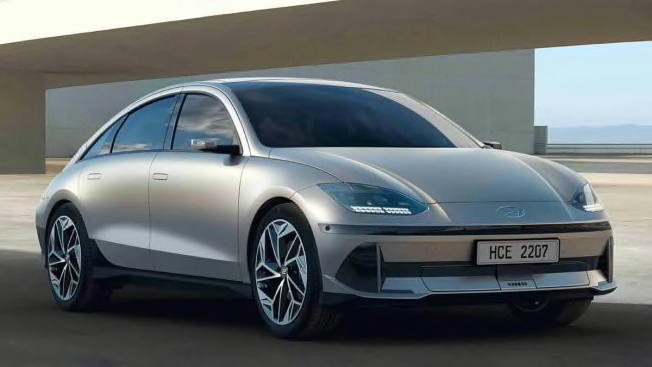
Photo: Hyundai Photo: Hyundai
Plus, its luxury brand Genesis launched its first electric vehicle, the GV60, based on a platform shared with the Hyundai Ioniq 5 and Kia EV6. Product rollout continues with the Genesis Electrified GV70 SUV and second-generation Kia Niro.
The company has committed to all its new vehicles being purely electric starting from 2025 with fuel-cell EVs and battery EVs, with the goal of being a 100 percent zero-emission vehicle brand by 2030 and carbon-neutral by 2035. In March 2022, HMC announced that it targets selling 1.87 million battery electric vehicles annually by 2030, worldwide. To achieve this goal, the automaker has pledged to introduce 17 new models by then, with 11 for the Hyundai brand and six for Genesis.
Read our Genesis G80 Electrified first drive.
Jaguar Land Rover Limited
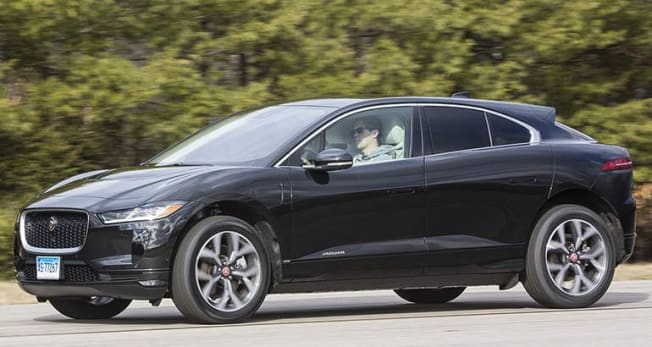
Photo: Consumer Reports Photo: Consumer Reports
The storied English brands Jaguar and Land Rover have been a subsidiary of Tata Motors, an Indian multinational firm, since 2008. The Jaguar side of the company has already made waves with its Tesla-fighting electric SUV, the I-Pace, and the company says the Land Rover side will have its first EV model by 2024. (Learn about the 2023 Land Rover Range Rover Sport.)
The company announced that all Jaguar and Land Rover models will have an electric version by the end of the decade, with six new electric Land Rover SUVs over the next five years and an all-electric Jaguar lineup by 2025.
Kia Motors America
Following its corporate partners Hyundai and Genesis, Kia has announced a road map for its electric vehicle plans. The big target is 1.2 million annual battery electric vehicle sales worldwide by 2030. Key to achieving that goal is increasing its EV lineup to 14 electric models by 2027.
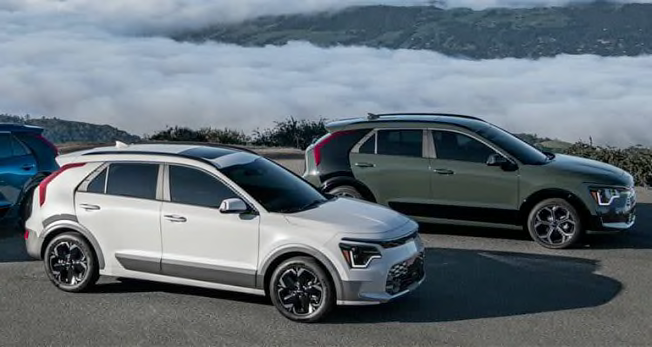
Photo: Kia Photo: Kia
Kia already offers an electric version of its Niro, and a second-generation Niro will be offered as a hybrid, a plug-in hybrid, and an EV. The automaker’s first purely electric model is the 2022 EV6 based on the same E-GMP platform—a modular, EV-specific substructure with the batteries mounted in the floor—that will underpin Ioniq-branded EVs from Hyundai.
Read our Kia EV6 first drive.
Mazda Motor Company
Mazda joined the electric revolution in fall 2021 when its all-new MX-30 SUV went on sale in California.

Photo: Mazda Photo: Mazda
Availability will expand to other states in 2022, with a national rollout to follow based on customer demand. This is an important and essential move for Mazda. But as an electric vehicle latecomer, the initial version appears to be outdated in terms of battery size and range, at just 100 miles, according to the Environmental Protection Agency’s estimate. That will significantly limit its appeal, especially when factoring in range loss over time and colder weather.
Read our Mazda MX-30 first drive.
Mercedes-Benz USA
Mercedes-Benz has committed to an aggressive electric-focused plan backed by $47 billion in funding.
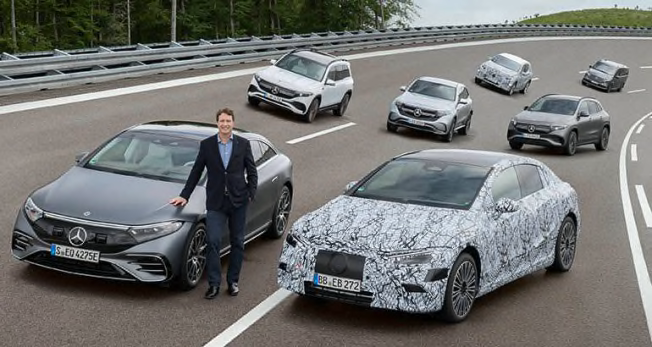
Photo: Mercedes-Benz Photo: Mercedes-Benz
The automaker announced that all newly launched vehicle platforms will be electric-only from 2025 onward and that it’s preparing for new cars to be electric-only by the end of the decade, with the important caveat “where market conditions allow.”
Three platforms are scheduled to launch in 2025: MB.EAm for medium and large cars, AMG.EA for performance cars, and VAN.EA for vans and light commercial vehicles. To power these new models, Mercedes plans to set up eight “gigafactories” with partners to produce batteries.
Mercedes’ electric push began in 2007 with an EV version of the diminutive Smart ForTwo city car. Now the automaker says it has plans to introduce 10 new EV models this year.
Mercedes has launched the EQS, an electric version of its opulent flagship S-Class sedan, and it has unveiled the EQS SUV, which goes on sale in late 2022. Looking ahead, Mercedes-Benz Vans announced a partnership with Rivian to collaborate on van production.
Read our Mercedes-Benz EQS first drive.
Mitsubishi Motors North America
New BEVs on the horizon? Not yet.

Photo: Mitsubishi Photo: Mitsubishi
Mitsubishi has a limited presence in North America. But it has been partly owned by Nissan since 2016 and has access to significant technical resources through the Renault-Nissan-Mitsubishi Alliance. Mitsubishi introduced the short-lived i-MiEV, a small electric hatchback, around the same time as the Nissan Leaf dawned, and currently has plug-in hybrid models in the U.S.
The company announced plans to expand its electrified (hybrid, plug-in hybrid, and EV) lineup to 50 percent of its global sales by 2030, then on to 100 percent electrified by 2035. It stated that it will work in collaboration with its corporate alliance partners to achieve these goals.
Nissan North America
Over the past decade, Nissan has sold half a million Leaf EVs around the world. As one of the first mass-market EVs available in the U.S., it has been a staple of the growing electric fleet. The company’s latest North America-bound electric model is the Ariya, a small SUV.

Photo: Nissan Photo: Nissan
The company will continue to evolve its lithium-ion battery technology as it prepares to launch an EV by 2028 that uses its own proprietary solid-state batteries.
The automaker has announced that it will invest about $18 billion into electrification and launch 23 electrified models, including 15 EVs, worldwide, by 2030. It forecasts that by then, 40 percent of its sales in the U.S. will be EVs. Nissan said its goal is to be carbon-neutral across the life cycle of all its vehicles by 2050.
Nissan’s luxury brand Infiniti is expected to expand its electric offerings as well.
StellantIs North America
In early 2021, the auto manufacturer formerly known as Fiat Chrysler Automobiles merged with Groupe PSA, the company that houses the French Peugeot and Citroën brands, to become Stellantis. In North America, Stellantis includes the Alfa Romeo, Chrysler, Dodge, Fiat, Jeep, Maserati, and Ram truck brands.
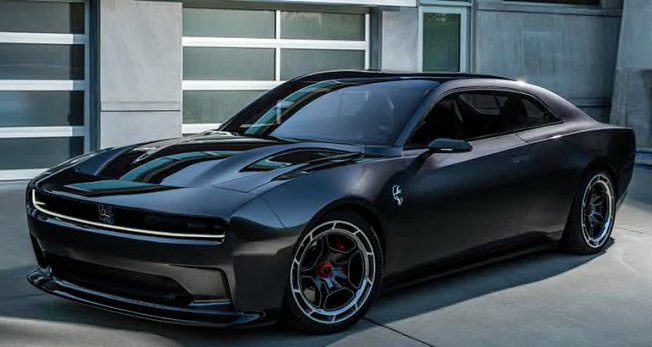
Photo: Dodge Photo: Dodge
Stellantis announced a major worldwide EV initiative in July 2021, declaring that all its brands are committed to offering fully electric vehicles. Key to this is the introduction of four electric platforms, with ranges from 300 to 500 miles.
In the U.S., the company known for its Hemi V8 engines aims to have its first battery electric vehicle by 2025 and to have an all-electric lineup by 2028. Stellantis said it expects battery costs to drop significantly over the next few years, helping it with the ambitious transition. By 2024, it expects to have two battery technologies in place (a high-density option and a nickel cobalt-free version), with solid-state batteries available by 2026.
Among the product plans, Jeep aims to introduce four all-electric vehicles by 2025, and it plans to offer 4xe plug-in models by then across the entire portfolio. (The automaker says the Wrangler 4xe is the best-selling plug-in hybrid in America.) The automaker projects that half of its sales in the U.S. will be battery-electric vehicles by 2030. Showcasing its future plans, Jeep has shown the Recon and Wagoneer S concepts.
Dodge pledges an electric muscle car—think a Charger that uses a charger—in 2024. It will also adapt the Alfa Romeo Tonale to serve as the Dodge Hornet small SUV, available as a plug-in hybrid.
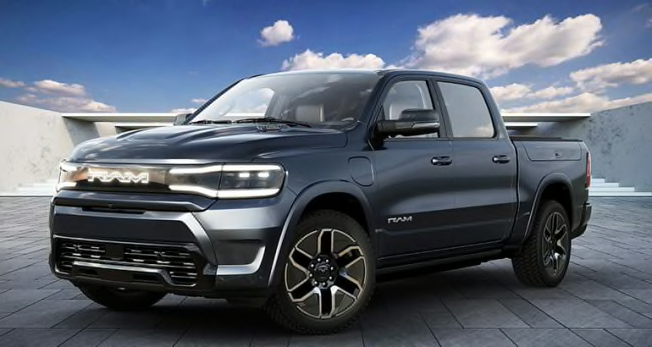
Photo: Ram Photo: Ram
Ram plans to launch a full-sized electric pickup truck in 2024, dubbed 1500 REV. It was previewed by the Ram 1500 Revolution BEV concept, which showcased several notable convenience features, such as the ability to stow pass-through items that stretch up to 18-feet long due to a folding midgate separating the cabin from the bed; third-row jump seat; four-wheel steering; and Shadow Mode, the ability for the truck to independently follow the driver walking. However, details on the production model, which looks quite different than the concept, have not been released yet.
Subaru of America
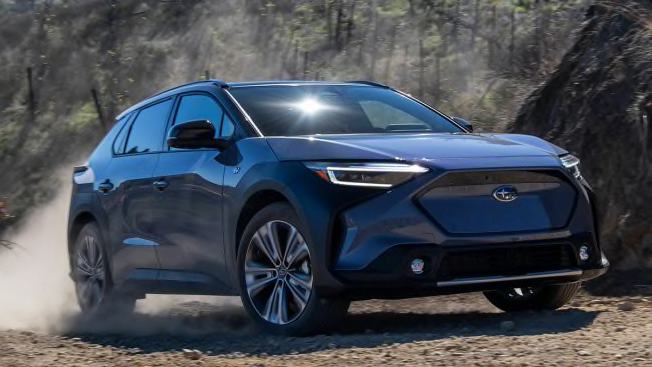
Photo: Subaru Photo: Subaru
Subaru has long been associated with its horizontally opposed “boxer” engines that feature two pairs of cylinders that lie flat and supposedly allow for a lower center of gravity. But the automaker announced in early 2021 that it would offer some form of electrification on all its models by mid-decade.
Subaru has made its entrance into the electric vehicle market with an all-electric SUV called the Solterra. It was developed as part of a joint venture with Toyota, which calls its version the bZ4X. The Solterra is built in Japan and China on Toyota’s new dedicated all-electric vehicle platform.
Read our Subaru Solterra first drive.
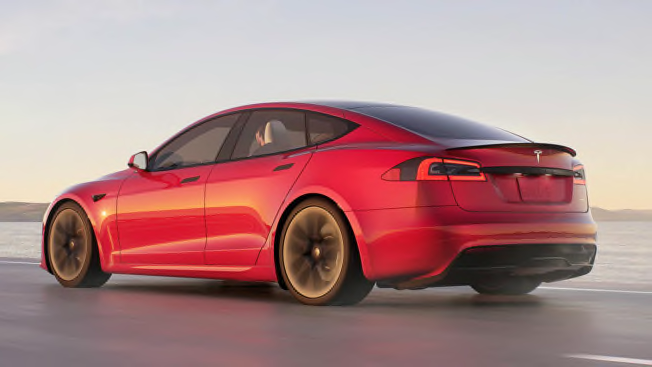
Photo: Tesla Photo: Tesla
The latter vehicles are known for impressive driving range and technological innovation, particularly in regard to ongoing improvements through over-the-air updates and driver assistance systems.
The Model 3 sedan has broadened the brand’s appeal. The line also includes the recent Model Y crossover, delivering a driving range of 300-plus miles but a stiff ride. The Model S has just received a significant update with a freshened exterior and interior, as well as a new Plaid high-performance version.
The Tesla Cybertruck rocked the automotive world when the prototype was unveiled in November 2019. It boasts big numbers, with sports-carlike acceleration, a heavy-duty truck-grade tow capacity, and a 500-mile range. Deliveries are now expected in 2023. After that, Tesla plans to roll out its Semi tractor-trailer truck followed by its next-generation Roadster. A bit of a misnomer, the Roadster is a four-seater with a snug back seat and a partly retractable hardtop. It uses three motors powering all wheels to deliver its claimed rocketlike acceleration, with the automaker citing 0 to 60 mph in 1.9 seconds. And it will offer 620 miles of range.
Toyota Motor Sales
Along with its luxury division, Lexus, Toyota has been building cars and SUVs with hybrid powertrains for decades now. In 20 years of Prius production, Toyota has sold more than 6 million of the utilitarian hybrids, which are known for their efficiency and reliability.

Photo: Toyota Photo: Toyota
Toyota announced its latest electrification goalposts in December 2021, promising to build 3.5 million battery-only electric vehicles per year, worldwide, by 2030, backed by $70 billion in investments. The effort would bring 30 new models—about a quarter of them battery electric vehicles—globally across the Toyota and Lexus brands. In a video presentation broadcast from Tokyo, Akio Toyoda, president of the Toyota Motor Corporation, showed off about a dozen electric concept vehicles—including cars, pickup trucks, and SUVs—that could reach production in the coming years.
Although Toyota hasn’t gone into much detail yet regarding most of its coming EV models, company executives have been clear in that they consider cars powered purely by batteries as only part of the company’s future lineup, in stark contrast to other manufacturers that have indicated they’re all in on pure EVs.
The automaker did, however, promise that Lexus, Toyota’s luxury brand, would be 100 percent electric by the end of the decade in the U.S. Koji Sato, president and chief branding officer of Lexus International, said at the presentation that the first Lexus EVs would accelerate quickly and have well over 400 miles of range. The brand kicked off this initiative with the 2023 RZ 450e SUV, the first Lexus EV. Sato also said there were even plans afoot for an electric Lexus sports car. In August 2022, it announced a $2.5 billion investment in a new battery plant to be built in North Carolina to support its hybrids and EVs.
The Toyota bZ4X electric SUV, the companion EV to the Subaru Solterra, is the first model of this EV wave to reach the market. These SUVs were jointly developed by the two automakers using a common platform, e-TNGA. Think Toyota electric components plus Subaru’s rich history with all-wheel-drive systems, and you get the picture. Toyota says the bZ4X will fall under its Toyota bZ—“beyond zero”—brand umbrella, a name that’s a reference to zero emissions. There are six other bZ models to be introduced by 2025.
Volkswagen Group of America
In the wake of its diesel emissions scandal—called Dieselgate by many observers—Volkswagen committed itself to becoming an EV-focused auto manufacturer. Volkswagen Group includes Audi, Bentley, Bugatti, Lamborghini, Porsche, and Volkswagen under its umbrella.

Photo: Volkswagen Photo: Volkswagen
The corporation says it will launch 70 pure electric vehicles and 60 hybrids by the end of the decade, some of which are already in production.
The new product wave was kicked off with the Volkswagen ID.4, a small electric SUV aimed at mass-market consumers that is now produced in the U.S. The automaker is preparing to launch the long-anticipated ID.Buzz electric van. Audi has the E-Tron and E-Tron GT, which is built on the same platform as the equally fetching Porsche Taycan EV.
Next up for Volkswagen is the ID.7 electric sedan, shown above in special camouflage, ahead of the reveal for the production version in spring 2023. It is based on the MEB architecture shared with other recent Volkswagen EVs.
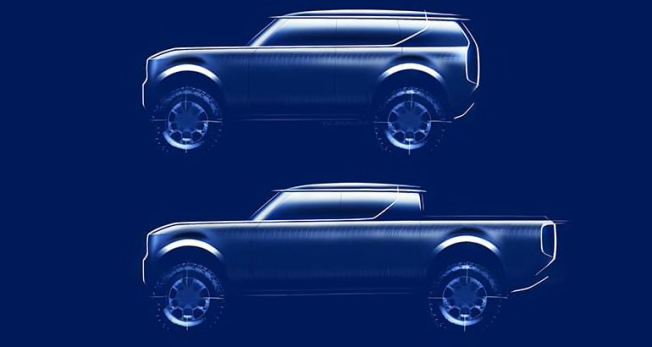
Photo: Volkswagen Photo: Volkswagen
Volkswagen announced in May 2022 that it will develop an all-electric SUV and pickup truck for the U.S. market under the Scout brand name. A prototype will be shown in 2023, with production scheduled to start in 2026.
Even Bentley will get in on the EV revolution. Its CEO says all Bentleys will be plug-ins—either hybrid or pure electric—by 2026, and electric-only by the end of the decade. The Lamborghini arm has been more coy about potential electrification plans, although the Terzo Millennio concept unveiled in 2017 invites speculation.
Volvo Group North America
New BEVs on the horizon? Yes.
Volvo has been straightforward about its plan to build only pure electric vehicles by the end of the decade. Zhejiang Geely Holding Group—the Chinese company that also owns Lotus—has owned Volvo since 2010.
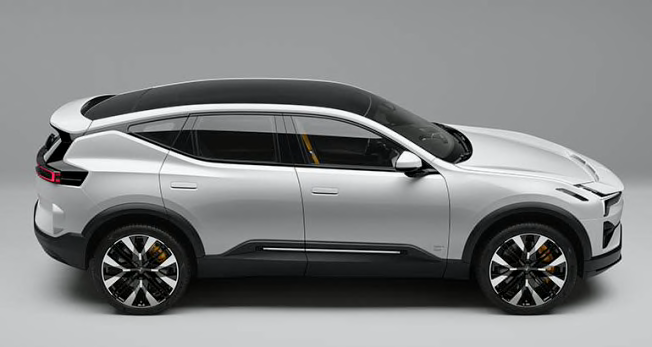
Photo: Polestar Photo: Polestar
The automaker’s performance EV brand, Polestar, will launch the American-made Polestar 3 SUV in late 2023, followed by the Polestar 4 SUV coupe in 2023 and Polestar 5 four-door GT, based on the Precept concept car, in 2024.




















